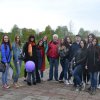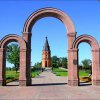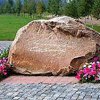Mogilev “Buinichi Field” memorial complex (08.05.2015)
Students from GROUP AF-13 together with Mel Rogers and Evgeniy Samsonov organized a trip to the memorial complex to commemorate the heroic defenders of Mogilev city in 1941.
“Buinichi Field” Memorial Complex, situated to the right of Buinichi village of Mogilev district. This is the field of glory of soldiers and officers of № 388 rifle battalion, № 340 light artillery battalion, № 174 tank-destroyer division, volunteers from different enterprises and institutions, who during 23 days resisted German tanks and motorized infantry. Commander of № 388 rifle battalion S. Kutepov was at the head the defended locality; soldiers of this subdivision set on fire more than 180 German tanks, killed hundreds of fascists. 39 German tanks were destroyed just in one of the battles.
“Buinichi Field” Memorial Complex consists of an arc and a central composition—a 27-meter chapel—that are joined by an alley. The chapel represents traditional east-Slavonic style of architecture. Its interior walls, faced with marble, has memorial plaques with hundreds of soldiers, officers, militiamen, etc., who had died during defence of Mogilev. “The Book of Memory” of Buinichi Field is placed in the centre of the memorial on a small embankment. Under the chapel there is a crypt where remains of soldiers of the Red Army are re-buried, when found in the city surroundings.
The students paid tribute, visited the chapel, walked along the alleys and recited poems in front of the Memorial stone to K. Simonov.
The memorial stone was set to commemorate Konstantin (Kirill) Simonov, a writer and a journalist, who was the first to glorify the heroic defence of Mogilev city; according to the writer’s last will, after death his ashes were drifted in Buinichi Field, together with ashes of other soldiers, whose names are either known or unknown. There is the inscription on the stone “K. M. Simonov 1916–1979. All his life he remembered this battlefield of 1941, and willed to drift his ashes here.”
Alleys radiate from the chapel to connect it with the arc, memorial stone to a writer K. Simonov, and the so-called “Lake of Tears”. To the right from the chapel there are the remains of tank ditch. In the field itself one can see different types of weaponry, including the German tank that had been found in the Druts river. No-where in the world you will find the tank of this modification in a better condition, specialists say.
Buinichi Field is a place where courage, heroism, self-sacrifice, and patriotism interconnected. The remains of those who had given their lives for the Motherland were reburied into common graves, including a crypt under the chapel of “Buinichi Field” Memorial Complex.
We, descendants of those soldiers and citizens, who gave their lives and helped the country to win, have now the opportunity to live peacefully, study, have families, be optimistic about our and our children’s future. We remember your heroic sacrifice in the Great Patriotic War. And we are grateful.












